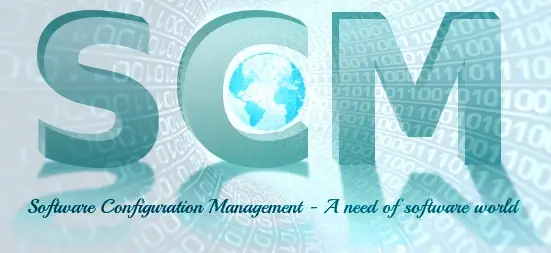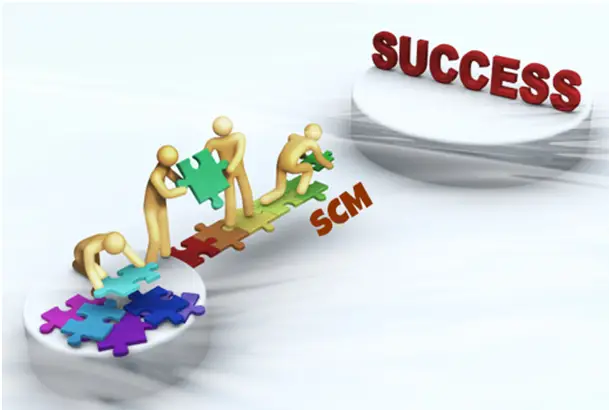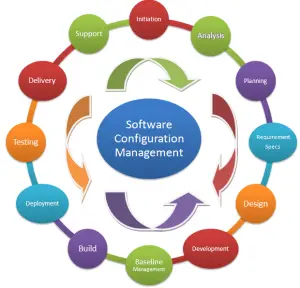
In today’s world where we are becoming more and more digital and everything depends upon software, software management is a real challenge. All the software projects are getting more complex and complicated in terms of logic, size, difficulty, and technologies used for them.
In every organization, daily a new fix/enhancement is added to the project that makes the software management even more complex and the response time to get it done is very less.
All software’s are subjected to constant changes during each phase of the software life cycle, such as planning, design, development, and even after development.
Here, Software Configuration Management (SCM) comes into the picture.
The need for software configuration management is no more unknown to anyone in this digital world and it’s well pronounced than ever.
Software configuration management is a method of bringing control to the software development and software management process. It enhances productivity and boosts application quality.
SCM is a process used for more efficiently developing and maintaining software, which is accomplished by improving accountability, audit-ability, reproducibility, traceability, and coordination.
Importance and Need of SCM
Let’s assume an example of the organization where they didn’t opt SCM process and started working on the project. They gathered the requirements from the client but neither they identified any control change nor accounted for it.
The team started developing the code in an ordinary system and built software out of it. They then deployed it manually without using any tool and showed it to the client. The client was happy with the front look.
After some days someone found a bug in login functionality and developers started working on it.
Only one user was working on the affected module while others were just waiting for him to finish his work.
Few days later other users also modified their code and they decided to deploy it.
This time they took a backup (a full backup which consumed a lot of disk space) of their code before deploying it.
But later one of the team members changed something by mistake and he didn’t inform anybody, at the same time another team member found out that a text box and the graphics are not looking good.
He modified the code slightly without taking a backup because the disk was almost full and showed it to the client. The client asked them to put the same page which was shown to him the first time.
Now here the trouble started:-
The team didn’t document the configuration items and changes, they modified the code without any backup and they were not able to recognize who has changed the logic.
They had to rework the same piece of work which they did before.
If they would have chosen an SCM process and implemented any version control system then they just have to take out the old version of code from the repository and were able to work in parallel when they found a bug.
They would have easily identified who had changed the code and moreover the user himself would have been able to revert it without any trouble.
They would have also used one of the SCM build & deployment tools to save the exhausting manual work of building and deploying the code.

Without SCM, every organization always comes across numerous common software problems. Some examples of these problems are missing source code, changed component libraries, incapability to do parallel development, an inability to track why, when, and who made a change, and difficulty in finding out why the program which was working earlier has suddenly stopped working.
These problems are really frustrating because they are difficult to fix and they reoccur frequently in the software field.
For example, a difficult bug that was fixed previously suddenly reappears, the updated version of the requirements document is not found, a developed and tested feature is missing or the source code and the executable program are of different versions.
SCM definitely helps to eliminate these problems by implementing the best processes of it. SCM plays an important role in the software life cycle by ensuring what was designed is the same as what is built and deployed.
The SCM Process
SCM process comprises of:
- Identification of configuration items and Baseline management.
- Documentation of characteristics.
- Controlling change.
- Configuration status accounting.
- Auditing and Reproducibility.
- Build and Deployment Management.
- Process and Environment management.
- Continuous Integration and Continuous deployment.
- Defect tracking and traceability.
- Ensuring integrity, visibility, project coordination and project evolution.

SCM in DevOps
Software Configuration Management is an integral part of DevOps.
SCM enables the DevOps culture with a variety of tools, concepts, principles, and processes.
SCM is quite an old terminology while the name DevOps got a boom just a decade ago.
To read more about DevOps, please refer to our article What is DevOps and How Does it Work?
Myths about SCM
Like any other software industry process, there are many myths about SCM. here are some familiar ones:
- A large scale software development can easily succeed without SCM.
- SCM will always slows down the software development process.
- SCM is a difficult and lengthy activity.
- SCM just provides version control system.
- SCM can only benefits developers or the SCM team.
- Once SCM implemented then the SCM tools will take care of everything.
- One SCM tool is compatible with every project.
- SCM is too expensive and tough to maintain.

SCM Best practice includes
Some of the best practices of SCM are :
- Always identify and store artifacts in a secure repository.
- Control and audit changes for artifacts.
- Require Change Requests and Change Packages
- Organize versioned artifacts into versioned components.
- Create baselines at project milestones.
- Record and track requests for change.
- Organize and integrate consistent sets of versions using activities.
- Maintain stable and consistent workspaces.
- Support concurrent changes to artifacts and to components.
- Integrate early and frequently.
- Ability to do continuous build and deployments.
- Ensure absolute reproducibility for all artifacts.

Benefits of SCM
SCM not only benefits just the development & SCM teams but also plays an important role for Business Analysts, Program managers, Testing and Quality Assurance teams.
Some of the benefits of SCM are as follows:
- Gives ability to work as distributed team across the globe and saves time for everyone.
- Manages complex business processes and provides auditable software every time.
- Provides an ability to go back to last working stage or any previous stages as per requirement.
- Improves management control over software development activities.
- Reduces manual efforts and makes the source code traceable.
- Improves software development productivity and organizational competitiveness.
- Better customer service and high return on investment.
- Prevents the risk of losing functioning code or breaking test scripts by overwriting files.
- Improved security and higher software reusability.
- Lower software maintenance costs with better quality assurance.
- Quicker problem identification and bug fixes with reduction of defects and bugs.
- Process-dependent development rather than person-dependent development.
- Gives assurance that the correct system is build every time.

Words to the wise
Users recognize the importance of SCM only when things go wrong in the project, but sometimes it is too late, and getting a project back on track can be a tedious task without SCM.
The complete implementation of SCM is not a piece of cake. The team has to do a lot of work to implement and keep an SCM system in good shape, but frankly speaking, the whole effort is worth every penny. You will realize it once you have a well-implemented SCM in your organization.
To avoid any failure later in the process, the SCM system should not just be implemented for the sake of certification or audit purposes. It should always be cautiously designed, properly implemented, and practiced systematically before you actually start working with SCM.
SCM can help you to stop any trouble before it actually starts and with the help of it you can make sure that you are building comprehensive and reliable software.
I hope this article gives you a fair amount of idea on what SCM is and what are the other essential things that you need to know about it!
If you require any help or have any feedback – please spare some time and leave a comment 🙂
The next article is all about Version control systems – what is VCS, what is the use, why it’s needed in any organization, etc.
Stay tuned!


Awesome article man !! Nice and very helpful
Well……you have done a really nice job. Appreciate your efforts in describing the process
I was searching for simliar kind of blog since many days, its strange that only few individuals have written anything on SCM …….. I must say you have written an excellent post 🙂
Very helpful post, Thanks
Very helpful article and i am keenly waiting for your next post 🙂
Hey Ravi, nice work man …… i liked the way you highlighted everything – keep it up
Its amazing ….. would like to read more about it
Great work man! It actually created a visual representation inside my mind. A big thumbs up 👍
Nice keep it up
Hi there, after reading this amazing article i am as well delighted to share my know-how here
with mates.
Thank you for your forum.Really thank you! Awesome
I needed to thanks for this excellent read!! I definitely loved every little bit of it.
on a regular basis i utilized to read smaller articles that at the same time clear their motive, and that
is also happening with this particular post that i am reading here.
I like what I see so now i am following you. Look forward to checking out your web page again.
Thanks for the great manual
Very useful information provided on SCM. I liked the way it’s describe the each and every detail.
Simple enough for a newbie to understand.
Good article. Explained in simple words.
Great work
Ravi – Very Comprehensive details. I have been in the SCM area for more than a decade, never came across a site listing the details this clearly.
I will keep reading the other articles also.
Having some workflow diagrams and providing the Scenarios – how the new feature gets delivered OR a defect gets delivered makes it more clear to all types of people – different roles.
Hi Prameela
Thanks for the feedback.
I would request you to please visit below articles which you might find useful for the workflows and procedures :
– https://devopsbuzz.com/devops-all-you-need-to-know/
– https://devopsbuzz.com/continuous-integration-vs-continuous-delivery-vs-continuous-deployment/
These 2 additional links on Devops/CI/CD are also very useful Bro…
Thanks to Prameela as well here who triggered you to provide these links… 🙂
Warm Regards
Nice post! Thank you.
I don’t even know how I ended up here, but I thought this post was great. I don’t know who you are but definitely you’re going to a famous blogger if you are not already 😉 Cheers!|
It’s actually a cool and useful piece of information. I am happy that you simply shared this helpful information with us. Please stay us informed like this. Thank you for sharing.|
Nice Article…..
Ravi – Does SCM takes care of all like Storage/Build/Release/Deployment/Change/Configuration Management as a whole ? Does it include repository ? Why GIT & GITHUB/Bitbucket are different & GIT though is a VCS,doesn’t have repository/DB for storage & depends on GITHUB for repository/storage ?
one SCM tool can implement CI/CD,Jenkins/Bamboo or any Devops CI/CD can be called as SCM tool as well?
Long list of questions but imp for me to know(may be for someone else as well)… 🙂
Hi Pk,
Thanks for the queries
Regarding Git (github), I have answered in your below comment.
For SCM, as elaborated in this article – It’s a method of bringing control to the software development and software management process. It enhances productivity and boosts application quality. SCM is a process used for more efficiently developing and maintaining software, which is accomplished by improving accountability, audit-ability, reproducibility, traceability and coordination. So, in short – Yes it takes care of every activity/process which is involved in making the software.
Every tool has its own feature and place in DevOps Cycle.
Suppose if we consider Jenkins, Bamboo, TeamCity, etc – they are use to implement CI/CD.
Puppet, Ansible, Chef, etc used for Configuration Management.
Nagios, AppDynamics, Splunk, etc used for Monitoring.
Similarly every tool has its own role in the cycle and associated benefits.
Hope this helps !!
Why GIT though its a VCS does not have a repository & depends on GITHUB ?
Please correct me if I am missing something here.
Hi Pk
Thanks for the query.
Actually GitHub is a Git repository hosting service. If you are referring git – that’s a VCS and every VCS has repository.
Please refer : https://devopsbuzz.com/centralized-vs-distributed-version-control-systems/ for more details
Great goods from you, man. I have bear in mind your stuff previous to and you’re just too magnificent.
I really like what you have obtained here, really like what you are
stating and the best way wherein you are saying it.
You are making it entertaining and you continue to take care of to keep it sensible.
I can’t wait to read much more from you. This is actually a great web site.
I used to be able to find good info from your blog posts.|
Hi there, I enjoy reading through your post. I wanted to write a little comment to support you.
Thanks for finally writing about > Software Configuration Management (SCM Complete Guide) – Loved it!
Hey There. I discovered your blog using msn. This is a very well written article.
I’ll make sure to bookmark it and come back to learn more of
your helpful information. Thanks for the post. I will definitely return.
I couldn’t resist commenting. Perfectly written!
Do you mind if I quote a couple of your posts as long as I provide
credit and sources back to your blog? My blog is in the very same niche as yours and my visitors would certainly benefit from a lot of the information you present here.
Please let me know if this ok with you. Thanks a lot!
Hi Ron,
Thanks for the request. Please feel free to quote the posts in your blogs as long as they follow the general guidelines.
Appreciate the recommendation. Let me try it out.
A round of applause for your blog post.Really looking forward to read more. Really Cool.